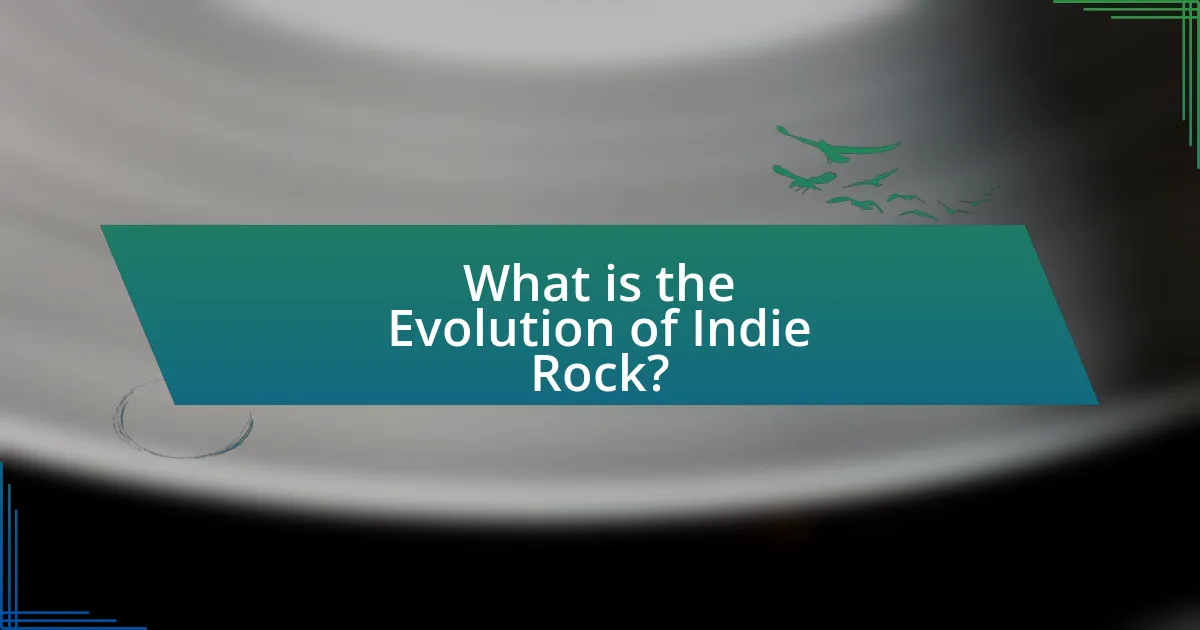The article examines the evolution of indie rock, tracing its origins from the 1980s as a response to mainstream music, characterized by independent labels and a DIY ethos. It highlights key developments through the decades, including the influence of grunge and alternative rock in the 1990s, the impact of the internet in the 2000s, and the ongoing diversification of sounds and themes in contemporary indie rock. The article also discusses the role of independent labels, the challenges faced by emerging bands, and the significance of technology and social media in shaping the current landscape of indie rock. Insights into how emerging bands innovate and contribute to the genre’s evolution are also provided, emphasizing the future prospects for indie rock in a competitive music industry.

What is the Evolution of Indie Rock?
The evolution of indie rock began in the 1980s as a response to mainstream music, characterized by independent record labels and a DIY ethos. Initially, bands like R.E.M. and The Smiths gained popularity by producing music outside major label systems, which allowed for greater artistic freedom. The genre expanded in the 1990s with the rise of grunge and alternative rock, with bands such as Nirvana and Radiohead blending indie sensibilities with broader appeal. By the 2000s, the internet facilitated the emergence of new artists, allowing for diverse sounds and styles, exemplified by bands like Arcade Fire and The Strokes. This period saw a significant increase in the accessibility of music production and distribution, further diversifying the indie rock landscape. Today, indie rock continues to evolve, incorporating elements from various genres and reflecting contemporary social issues, while maintaining its core values of independence and authenticity.
How did Indie Rock originate and develop over time?
Indie Rock originated in the late 1970s as a response to the mainstream music industry’s commercialization, with bands seeking creative freedom and independence. Initially, it was characterized by a DIY ethic, where artists self-produced their music and distributed it through independent labels, such as SST Records and Rough Trade. Over time, the genre evolved through the 1980s and 1990s, incorporating diverse influences from punk, post-punk, and alternative rock, leading to the emergence of subgenres like lo-fi and shoegaze. The rise of the internet in the 2000s further facilitated the development of Indie Rock by enabling artists to reach wider audiences without traditional label support, exemplified by bands like Arcade Fire and The Strokes gaining mainstream success while maintaining their independent roots. This trajectory illustrates how Indie Rock has continuously adapted to cultural shifts while retaining its core values of artistic autonomy and innovation.
What key events marked the early days of Indie Rock?
The early days of Indie Rock were marked by several key events, including the emergence of independent record labels in the 1980s, the rise of college radio stations, and the DIY ethos that characterized the genre. Independent labels like SST Records and 4AD played crucial roles in promoting bands such as Sonic Youth and The Pixies, which helped to establish the sound and culture of Indie Rock. College radio stations provided a platform for these bands, allowing them to reach wider audiences and gain popularity outside mainstream channels. The DIY ethos encouraged artists to produce and distribute their music independently, leading to a diverse range of sounds and styles that defined the genre’s early landscape.
How did the sound of Indie Rock change through the decades?
The sound of Indie Rock evolved significantly through the decades, transitioning from the raw, lo-fi aesthetics of the 1980s to the polished production styles of the 2000s and beyond. In the 1980s, bands like The Smiths and R.E.M. emphasized jangly guitars and introspective lyrics, often recorded on low budgets, which defined the genre’s early identity. The 1990s introduced a broader range of influences, with bands such as Pavement and Neutral Milk Hotel incorporating experimental elements and diverse instrumentation, reflecting a more eclectic sound. By the 2000s, Indie Rock saw a shift towards mainstream acceptance, with artists like Arcade Fire and The Strokes blending indie sensibilities with polished production, leading to a more accessible sound. This evolution continued into the 2010s and 2020s, where genres like electronic and pop began to merge with traditional Indie Rock, exemplified by bands like Tame Impala and Vampire Weekend, showcasing a further diversification of sound.
What are the defining characteristics of Indie Rock?
Indie Rock is characterized by its emphasis on independent production, diverse musical styles, and a DIY ethos. This genre often features unconventional song structures, a focus on lyrical content, and a rejection of mainstream commercialism. Historically, bands like R.E.M. and The Smiths exemplified these traits in the 1980s, while contemporary artists continue to innovate within the genre, showcasing a wide range of influences from punk to folk. The rise of digital platforms has further enabled indie artists to reach audiences without major label support, reinforcing the genre’s core principles of artistic freedom and authenticity.
How do instrumentation and production techniques differ in Indie Rock?
Instrumentation and production techniques in Indie Rock differ significantly from mainstream genres, primarily through their emphasis on raw sound and DIY aesthetics. Indie Rock often utilizes unconventional instruments, such as synthesizers, banjos, and even found objects, which contribute to a unique sonic palette. In contrast, mainstream production typically favors polished sounds and standard instrumentation like electric guitars and drums.
Moreover, Indie Rock production techniques frequently involve lower budgets and home recording setups, leading to a more organic and less commercialized sound. This contrasts with mainstream practices that rely on high-end studios and professional producers to achieve a polished finish. For example, bands like Bon Iver have famously recorded in isolated locations, using ambient sounds to enhance their music, while mainstream artists often prioritize radio-friendly production values. This divergence highlights the distinct identity of Indie Rock, rooted in artistic expression over commercial viability.
What themes and lyrical content are prevalent in Indie Rock music?
Indie Rock music frequently explores themes of introspection, individuality, and social commentary. Lyrical content often reflects personal experiences, emotional struggles, and a sense of disconnection, which resonates with listeners seeking authenticity. For instance, artists like Sufjan Stevens and Phoebe Bridgers delve into topics such as mental health and existential questions, showcasing vulnerability in their lyrics. Additionally, many Indie Rock songs critique societal norms and consumerism, as seen in the works of bands like Arcade Fire and Death Cab for Cutie, who address issues like alienation and the search for meaning in modern life. This thematic diversity contributes to the genre’s appeal and relevance in contemporary music culture.
Why is Indie Rock significant in the broader music landscape?
Indie Rock is significant in the broader music landscape because it represents a movement that prioritizes artistic freedom and innovation over commercial success. This genre emerged in the 1980s and has since influenced mainstream music by introducing diverse sounds and unconventional approaches to songwriting. For instance, bands like Radiohead and The Strokes have shaped the sound of modern rock, blending various genres and pushing creative boundaries. Additionally, the rise of digital platforms has allowed indie artists to reach global audiences without major label support, further democratizing the music industry. This shift has led to a richer musical tapestry, showcasing a wide array of voices and styles that challenge traditional norms.
How has Indie Rock influenced mainstream music trends?
Indie Rock has significantly influenced mainstream music trends by introducing diverse sounds, DIY aesthetics, and a focus on authenticity. This genre has led to the incorporation of lo-fi production techniques and unconventional song structures in popular music, as seen in the works of artists like Arcade Fire and Vampire Weekend, who blend indie sensibilities with mainstream appeal. The rise of streaming platforms has further facilitated this influence, allowing indie artists to reach wider audiences and prompting major labels to adapt their strategies to include indie-inspired elements. For instance, the success of the song “Pumped Up Kicks” by Foster the People, which features an indie rock sound, demonstrates how mainstream music has embraced indie influences to achieve commercial success.
What role do independent labels play in the Indie Rock scene?
Independent labels are crucial in the Indie Rock scene as they provide essential support for emerging artists, enabling creative freedom and financial backing. These labels often prioritize artistic integrity over commercial success, allowing bands to explore unique sounds and concepts without the constraints typically imposed by major labels. For instance, independent labels like Sub Pop and Matador Records have launched the careers of influential bands such as Nirvana and Pavement, respectively, demonstrating their significant impact on the genre’s evolution. Additionally, independent labels often foster close-knit communities, facilitating collaboration and networking among artists, which further enriches the Indie Rock landscape.
How do Emerging Bands Contribute to Indie Rock’s Evolution?
Emerging bands contribute to indie rock’s evolution by introducing innovative sounds and diverse influences that challenge traditional genre boundaries. These bands often experiment with new musical styles, blending elements from various genres such as electronic, folk, and punk, which leads to the creation of fresh subgenres within indie rock. For instance, the rise of bands like Snail Mail and Phoebe Bridgers has incorporated introspective lyrics and lo-fi aesthetics, reflecting contemporary themes and resonating with younger audiences. This evolution is evidenced by the increasing presence of emerging artists on platforms like Bandcamp and Spotify, where they gain traction and influence the broader indie rock landscape.
What challenges do emerging bands face in the Indie Rock genre?
Emerging bands in the Indie Rock genre face significant challenges, including limited financial resources, difficulty in gaining exposure, and competition from established artists. Financial constraints often hinder their ability to produce high-quality recordings and promote their music effectively. Additionally, gaining exposure in a saturated market is challenging, as many platforms prioritize well-known artists, making it hard for new bands to reach potential listeners. Furthermore, the competition from established artists and other emerging bands intensifies the struggle for visibility and recognition in the Indie Rock scene.
How do financial constraints impact the production of Indie Rock music?
Financial constraints significantly limit the production capabilities of Indie Rock music. These limitations often result in reduced access to professional recording studios, high-quality equipment, and skilled personnel, which can compromise the overall sound quality and production value of the music. For instance, many Indie Rock bands resort to home recording setups or low-budget studios, which can lead to a less polished final product. Additionally, financial constraints can restrict marketing efforts, limiting the band’s ability to reach wider audiences and secure live performance opportunities. According to a study by the University of Southern California, 70% of independent musicians reported that budget limitations directly affected their ability to produce and promote their music effectively.
What strategies do emerging bands use to gain visibility and recognition?
Emerging bands use social media marketing, live performances, and collaborations to gain visibility and recognition. Social media platforms like Instagram, TikTok, and Twitter allow bands to engage directly with fans, share content, and promote their music, leading to increased exposure. For instance, TikTok has become a significant tool for music discovery, with viral trends helping songs reach wider audiences. Live performances at local venues and festivals enable bands to connect with audiences in person, build a fan base, and create memorable experiences that encourage word-of-mouth promotion. Collaborating with other artists or influencers can also amplify their reach, as partnerships often introduce bands to new audiences. These strategies are supported by data showing that 70% of music discovery now occurs through social media platforms, highlighting their importance in the modern music landscape.
How do emerging bands innovate within the Indie Rock genre?
Emerging bands innovate within the Indie Rock genre by experimenting with diverse musical styles, incorporating technology, and engaging with their audience through social media. These bands often blend elements from genres such as electronic, folk, and hip-hop, creating unique soundscapes that differentiate them from traditional Indie Rock. For instance, bands like Tame Impala have successfully fused psychedelic rock with electronic music, showcasing this innovative approach. Additionally, the use of digital platforms allows these bands to produce and distribute music independently, reaching wider audiences without traditional label constraints. This shift has led to a more diverse range of sounds and artistic expressions within the genre, reflecting the evolving landscape of music consumption and production.
What new sounds or styles are being introduced by these bands?
Emerging bands in the indie rock scene are introducing a blend of genres, incorporating elements from electronic music, hip-hop, and world music. For instance, bands like Snail Mail and Phoebe Bridgers are integrating introspective lyrics with lo-fi production, while others like Big Thief are experimenting with folk and avant-garde influences. This evolution reflects a shift towards more diverse soundscapes, as evidenced by the increasing use of synthesizers and unconventional song structures, which are reshaping the traditional indie rock framework.
How do collaborations among emerging bands shape the Indie Rock scene?
Collaborations among emerging bands significantly shape the Indie Rock scene by fostering innovation and expanding creative boundaries. These partnerships allow artists to blend diverse musical styles and influences, resulting in unique sounds that attract wider audiences. For instance, collaborations often lead to the creation of genre-defying tracks, as seen in projects like the supergroup Boygenius, which combines the talents of Phoebe Bridgers, Lucy Dacus, and Julien Baker, showcasing how individual strengths can enhance collective artistry. Furthermore, such collaborations can increase visibility for lesser-known bands, as they tap into each other’s fan bases, thereby promoting a more interconnected and vibrant Indie Rock community. This dynamic not only enriches the music itself but also encourages a culture of support and shared resources among emerging artists, ultimately driving the evolution of the genre.

What Insights Can We Gain from Current Trends in Indie Rock?
Current trends in indie rock reveal a significant shift towards genre-blending and increased digital engagement. Emerging bands are increasingly incorporating elements from various genres, such as electronic, hip-hop, and folk, which reflects a broader cultural acceptance of musical experimentation. For instance, artists like Phoebe Bridgers and Snail Mail exemplify this trend by merging traditional rock with introspective lyrics and diverse soundscapes. Additionally, the rise of platforms like Bandcamp and TikTok has enabled indie artists to reach wider audiences without traditional label support, as evidenced by the success of songs that go viral on social media. This democratization of music distribution highlights the changing landscape of the industry, where grassroots movements can lead to significant commercial success.
How is technology influencing the creation and distribution of Indie Rock music?
Technology significantly influences the creation and distribution of Indie Rock music by providing accessible tools for production and platforms for sharing. Digital audio workstations (DAWs) like Ableton Live and GarageBand enable artists to produce high-quality recordings from home, reducing the need for expensive studio time. Additionally, platforms such as Bandcamp and SoundCloud allow musicians to distribute their music directly to audiences without traditional record label constraints, facilitating a more democratic music landscape. According to a 2021 report by the International Federation of the Phonographic Industry, independent artists accounted for 40% of global music revenues, highlighting the impact of technology on their reach and financial success.
What role do social media and streaming platforms play in promoting Indie Rock?
Social media and streaming platforms are crucial in promoting Indie Rock by providing emerging bands with accessible channels to reach wider audiences. These platforms enable artists to share their music directly with fans, bypassing traditional gatekeepers like record labels. For instance, Spotify reported that over 60% of its users discover new music through its curated playlists, which often feature Indie Rock artists. Additionally, social media platforms like Instagram and TikTok allow bands to engage with fans, share behind-the-scenes content, and promote live shows, significantly increasing their visibility. The ability to go viral on these platforms can lead to substantial growth in an artist’s following and streaming numbers, exemplified by the rise of bands like Wallows and their success through social media engagement.
How are emerging bands utilizing digital tools for music production?
Emerging bands are utilizing digital tools for music production by leveraging software like Ableton Live and Pro Tools to create, edit, and mix their music efficiently. These tools allow bands to produce high-quality recordings from home studios, significantly reducing the costs associated with traditional studio time. Additionally, platforms such as Bandcamp and SoundCloud enable bands to distribute their music directly to audiences, facilitating greater reach and engagement. According to a 2021 report by the International Federation of the Phonographic Industry, 70% of independent artists now use digital platforms for music distribution, highlighting the trend among emerging bands to embrace technology for production and promotion.
What are the future prospects for Indie Rock and its emerging bands?
The future prospects for Indie Rock and its emerging bands are promising, driven by the genre’s adaptability and the increasing accessibility of music production and distribution technologies. Emerging bands are leveraging platforms like Bandcamp and Spotify, which have democratized music access, allowing them to reach global audiences without traditional label support. Additionally, the rise of social media enables these bands to cultivate dedicated fan bases and engage directly with listeners, enhancing their visibility and marketability. According to a 2022 report by the International Federation of the Phonographic Industry, independent music accounted for 40% of global recorded music revenues, indicating a growing acceptance and demand for Indie Rock. This trend suggests that as emerging bands continue to innovate and connect with audiences, the Indie Rock scene will likely thrive in the coming years.
How can emerging bands sustain their growth in a competitive music industry?
Emerging bands can sustain their growth in a competitive music industry by leveraging digital platforms for promotion and fan engagement. Utilizing social media channels like Instagram, TikTok, and YouTube allows bands to reach wider audiences and build a loyal fanbase. According to a 2021 report by MIDiA Research, 70% of music discovery now occurs through social media, highlighting its importance for emerging artists. Additionally, consistent content creation, such as regular music releases and engaging behind-the-scenes footage, keeps fans invested and encourages sharing, which can lead to organic growth. Collaborating with other artists and participating in live events, both virtual and in-person, further enhances visibility and networking opportunities, essential for long-term success in the music industry.
What best practices can emerging bands adopt to thrive in the Indie Rock scene?
Emerging bands can thrive in the Indie Rock scene by focusing on building a strong online presence, engaging with their audience, and collaborating with other artists. A robust online presence, including active social media engagement and a well-designed website, allows bands to reach a wider audience and showcase their music effectively. Engaging with fans through live streams, Q&A sessions, and behind-the-scenes content fosters a loyal community. Collaborating with other artists not only enhances creativity but also expands reach through shared fan bases. According to a 2021 survey by the Music Industry Research Association, 70% of emerging artists reported that social media significantly contributed to their fan growth, highlighting the importance of these practices.



